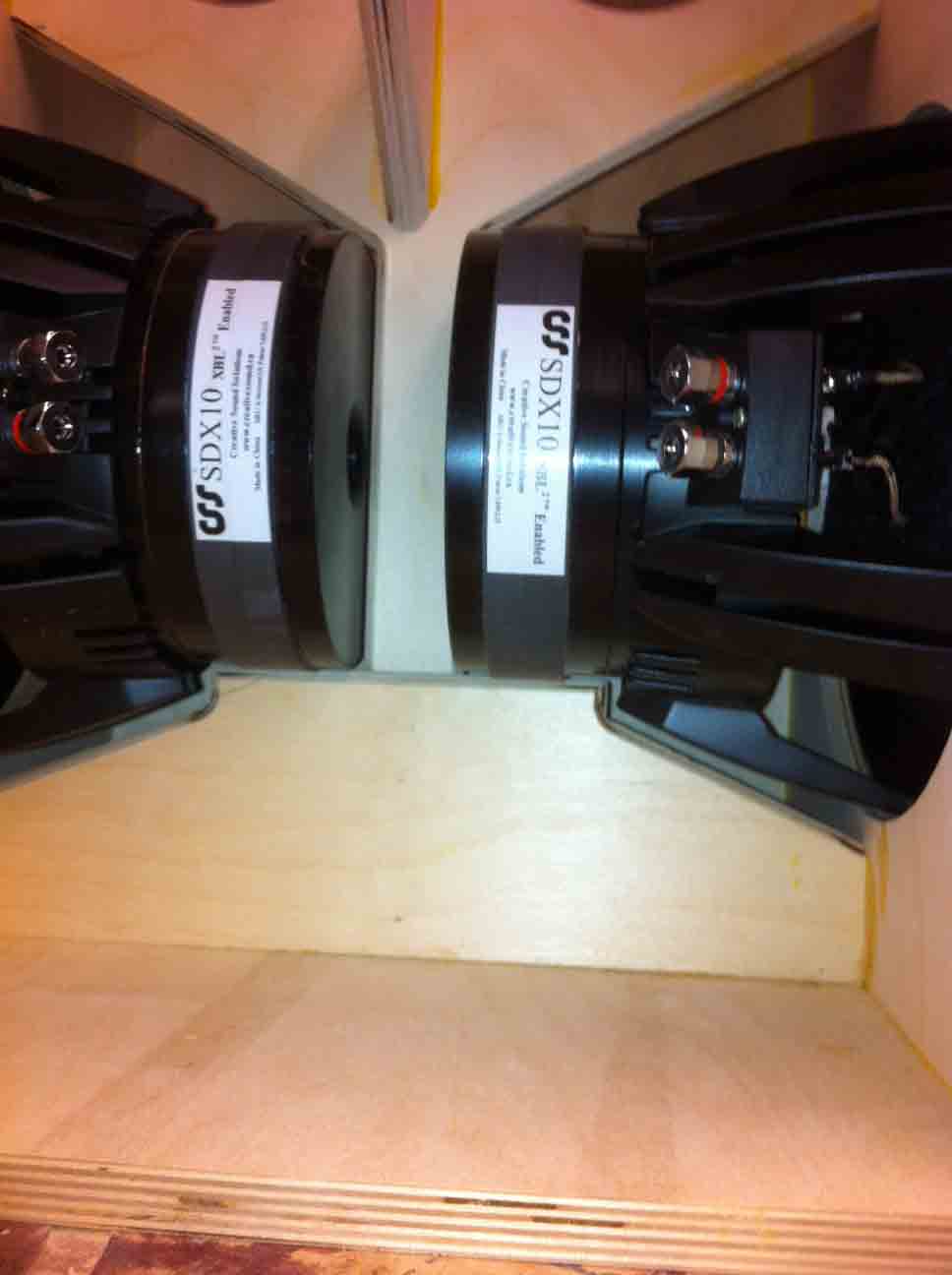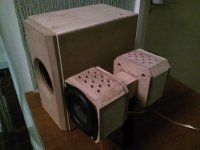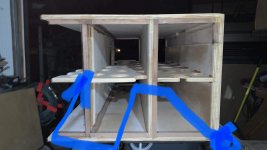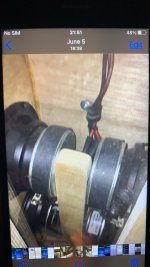My 4 * UM18-22 is on its way to my country, determining how I would build them.
My original plan was to use 0.86"(22mm) MDF to build 4 boxes. Then I found that dual-opposed-subwoofer(DOS) design fascinating.
Though I still need double internal volume, two boxes with volume V is always larger than a single box with volume 2V - I think it's a good way to save spaces.
Beyond that, I noticed that this DOS design cancels out the cabinet vibration.
Does that mean I can reduce the structural stiffness because the design reduces physical strain?
If that's true, is it ok to use 0.59"(15mm) MDF to get more internal volume and make the cabinet lighter?
Of course I would need tight braces but still, 7mm can make quite a big difference.
(If my calculation is right, my DOS UM18-22 would be heavier than 220lbs when made of 0.86" MDF - which is definately too much to handle.)
Hope I could get answers. Thanks!
My original plan was to use 0.86"(22mm) MDF to build 4 boxes. Then I found that dual-opposed-subwoofer(DOS) design fascinating.
Though I still need double internal volume, two boxes with volume V is always larger than a single box with volume 2V - I think it's a good way to save spaces.
Beyond that, I noticed that this DOS design cancels out the cabinet vibration.
Does that mean I can reduce the structural stiffness because the design reduces physical strain?
If that's true, is it ok to use 0.59"(15mm) MDF to get more internal volume and make the cabinet lighter?
Of course I would need tight braces but still, 7mm can make quite a big difference.
(If my calculation is right, my DOS UM18-22 would be heavier than 220lbs when made of 0.86" MDF - which is definately too much to handle.)
Hope I could get answers. Thanks!
Cabinet vibation is not necessarily the same thing. For example you'll still encounter the cabinet flexing as one due to the internal pressure. Sometimes called the breathing mode, it can be a significant mode. You'll also need to consider the panels will be larger due to the two woofers.
Thank you for sharing your thoughts!Cabinet vibation is not necessarily the same thing. For example you'll still encounter the cabinet flexing as one due to the internal pressure. Sometimes called the breathing mode, it can be a significant mode. You'll also need to consider the panels will be larger due to the two woofers.
I also found out that what we call MDF has diverse range of density.(400~800kg/m^3, and >900 is called "HDF")
I know that what I'm gonna use is 720kg/m^3, which I think is quite a heavy one.
What do you think the appropriate thickness is?
I think 3/4" is kind of a standard between DIYers, I want to know what density the "standard" is about.
Probably gonna make 31.5" x 21.5" x 21.5" cabinet with dual opposed UM18-22 on front and back double baffle, with 2 layers of braces.
I built double dual opposed with 1" front baffles. And immediately realised it was overkill because a) too bloody heavy to handle b) absolutely no vibration felt to the touch!

If I were to rebuild I would go with with 18mm MDF, or even less eg. 16mm
Of course YMMV, but do you have capability to measure?
If I were to rebuild I would go with with 18mm MDF, or even less eg. 16mm
Of course YMMV, but do you have capability to measure?
Thanks! It helped a lot
Yes I have earthworks to measure stuffs.. but still I have to put lots of efforts to get to that stage
Don't want to make irreversible misakes and start over 🙁
So I wanted to hear from people with experiences
Yes I have earthworks to measure stuffs.. but still I have to put lots of efforts to get to that stage
Don't want to make irreversible misakes and start over 🙁
So I wanted to hear from people with experiences
Last edited by a moderator:
Have further questions if you may,I built double dual opposed with 1" front baffles. And immediately realised it was overkill because a) too bloody heavy to handle b) absolutely no vibration felt to the touch!
View attachment 1110076
If I were to rebuild I would go with with 18mm MDF, or even less eg. 16mm
Of course YMMV, but do you have capability to measure?
1. Did you use 1" MDF on every part of your cabinet? I want to know if the 1" front baffle means double 0.5" MDF or double 1"(so 2" in total), or every side of the cabinet is 1".
2. What I see is two drivers in one side of the baffle. If you made it dual opposed, are there two more drivers in the opposite one?(so 4 drivers in total)
Or is it two drivers facing outside in the front baffle called DOS? If so, I thought two drivers facing opposite side was DOS. Confused. 🙁
It's not too difficult to modify internally to add braces or externally to add a constrained layer of damping.
MDF is a poor choice when making a subwoofer. You want a stiff box that has potential resonances well above the passband. Quality plywood is a better choice. And much lighter. Your back will thank you.
Push-push dramatically reduces the amount of reactive energy loaded into the box structure.
To prove a point we built a push-push 10” woofer out of 15mm BB. It works very well. I was able to gett he top moving but only when driving it way beyond sane levels. A chuk of granite or corian solves that.

Plans at the end. http://www.planet10-hifi.com/downloads/SDX10-woofPlans-240418.pdf
Now 2 18”, you want to use an 18mm baffle just because you are cutting such a large hole into it.
dave
Push-push dramatically reduces the amount of reactive energy loaded into the box structure.
To prove a point we built a push-push 10” woofer out of 15mm BB. It works very well. I was able to gett he top moving but only when driving it way beyond sane levels. A chuk of granite or corian solves that.

Plans at the end. http://www.planet10-hifi.com/downloads/SDX10-woofPlans-240418.pdf
Now 2 18”, you want to use an 18mm baffle just because you are cutting such a large hole into it.
dave
Have further questions if you may,
1. Did you use 1" MDF on every part of your cabinet? I want to know if the 1" front baffle means double 0.5" MDF or double 1"(so 2" in total), or every side of the cabinet is 1".
2. What I see is two drivers in one side of the baffle. If you made it dual opposed, are there two more drivers in the opposite one?(so 4 drivers in total)
Or is it two drivers facing outside in the front baffle called DOS? If so, I thought two drivers facing opposite side was DOS. Confused. 🙁
4 drivers in total.
Only 2 drivers are visible in the picture.
There are 2 more drivers on the opposing panel (not visible)
Panels where these drivers are mounted are 1" thick.
Going to use CNC for perfect result. Material is cheap but mistakes isn't for me.It's not too difficult to modify internally to add braces or externally to add a constrained layer of damping.
I'm surprised to hear that lightweight plywood can be better than mdf. Will reseach on that thanks!MDF is a poor choice when making a subwoofer. You want a stiff box that has potential resonances well above the passband. Quality plywood is a better choice. And much lighter. Your back will thank you.
Push-push dramatically reduces the amount of reactive energy loaded into the box structure.
To prove a point we built a push-push 10” woofer out of 15mm BB. It works very well. I was able to gett he top moving but only when driving it way beyond sane levels. A chuk of granite or corian solves that.

Plans at the end. http://www.planet10-hifi.com/downloads/SDX10-woofPlans-240418.pdf
Now 2 18”, you want to use an 18mm baffle just because you are cutting such a large hole into it.
dave
Still it's hard to believe they can hold 2 18" better than heavy mdf.
Thanks! helped me a lot4 drivers in total.
Only 2 drivers are visible in the picture.
There are 2 more drivers on the opposing panel (not visible)
Panels where these drivers are mounted are 1" thick.
If you may, can you tell me some theorical backgrounds why plywood can be better for subs?Heavy is not an asset.
dave
I'm googling but there are too many craps out there as always.
Mass lowers the resonance frequency. If having that mass also means you'll have a stiff panel then that's OK. The ratio is different for the different materials.
Like in stranded bamboo plywood. MDF is not that stiff. And it is heavy. 15mm quality plywood is as/or stiffer than ¾” MDF and much lighter so any potential resonances will be higher in frequency.If having that mass also means you'll have a stiff panel then that's OK
You cannot skimp on bracing. Plywood also tends to be better damped. Every transition from one ply to the next damps.
So for a woofer, light and stiff, push any potential resonances up above the bandwidth of the woofer and they ar enever excited.
dave
Mass lowers the resonance frequency. If having that mass also means you'll have a stiff panel then that's OK. The ratio is different for the different materials.
I did my homework, and manged to understand what you're talking, thanks!Like in stranded bamboo plywood. MDF is not that stiff. And it is heavy. 15mm quality plywood is as/or stiffer than ¾” MDF and much lighter so any potential resonances will be higher in frequency.
You cannot skimp on bracing. Plywood also tends to be better damped. Every transition from one ply to the next damps.
So for a woofer, light and stiff, push any potential resonances up above the bandwidth of the woofer and they ar enever excited.
dave
But I also found out that with plywood it is hard to get precision finish (angled edges, sleek grooves... etc) .
I was to use CNC to get sleek design, so maybe I have no choice but to stick to mdf.
Just one more thing.
I can choose between lower density mdf and higher density mdf(500kg/m^3 vs 720kg/m^3)
Do you think choosing lower version for my back is acceptable? In case I have proper amount of bracings.
Im ‘trying’ this with the um18 (in opposed pairs with motor ‘in’ not as shown during construction/fit up) mdf would be impossibly heavy 😳
Attachments
Last edited:
If you connect the magnets together, it reduced the vibration, but if you use only the cabinet to connect the drivers, I'd say it increases the forces, because with one drive it just shakes the cabinet, but with two they're hold still, which takes much more force; when they were testing a Maltra V12 F1 engine they found that it lost about 14 hp when they bolted it rigidly to the dyno - when the engine was free to vibrate the forces/friction was low, when the engine was stopped from vibrating the forces/friction was high. It is possible to have the drivers mounted so they "float" in the enclosure - see pic The dumb-bell is inserted from the rear, and a rear baffle fitted. The dumb-bell if held in place by foam.


Doing that by connecting the baffles together with braces is the same as connecting the magnets together, except for the part about the magnets dangling off the mounting frame through the basket. This happens anyway in most cases because it's typical to mount a woofer by the mounting surface/holes. However since the cone pushes against the magnet, magnet mounting excludes the basket resonance.
Doing that by connecting the baffles together with braces is the same as connecting the magnets together
If you want to have a REALLY solid connection, the baffles need to be tided together and the magnetics as well… unless you come up with a driver-t0-driver connection using something creative as is shown (somewhere here) in A Scandinavian Alpair7/Scanspeak WAW.
Having the magnets braced supports the cancelation of the reaction forces when the baskets are being pushed together, to assure good connection when the baskets are being pulled apart means the baffles need to not move.

dave
- Home
- Loudspeakers
- Subwoofers
- Dual-Opposed Sub - thinner MDF allowed?



